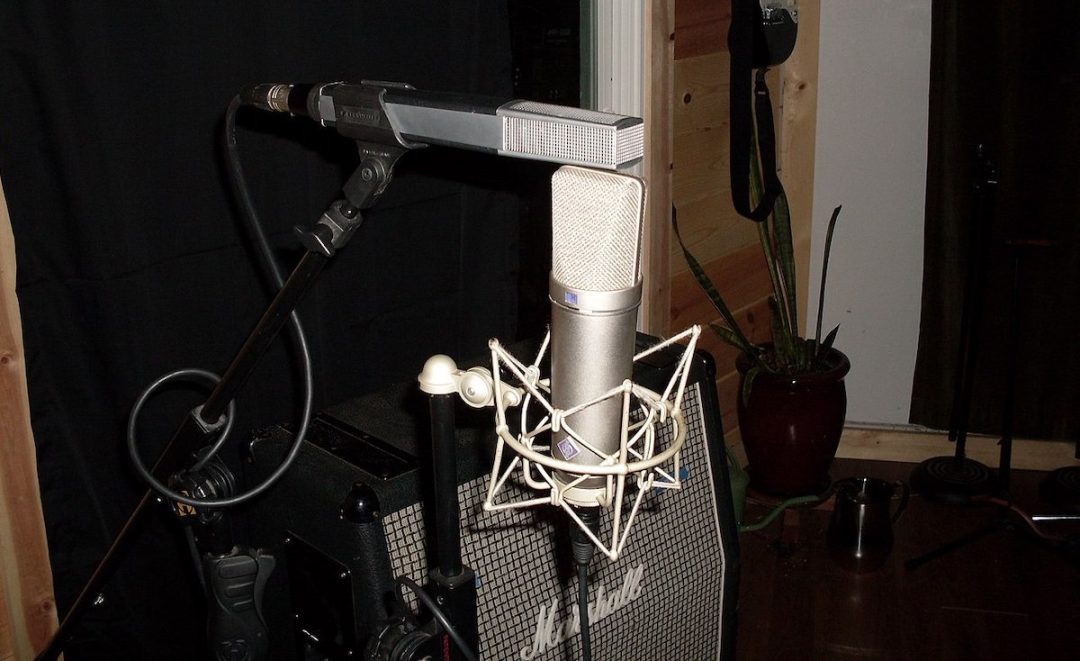The mid/side (M/S) miking technique is a common stereo recording device involving two microphones. It provides some serious advantages over other stereo recording techniques, and is an incredible tool in the studio.
What Is Mid/Side Stereo Recording?
Legendary EMI electronics engineer Alan Blumlein conceptually developed the mid/side miking techniques. Blumlein’s legacy includes 128 patents and credit as one of the most important inventors and engineers in history.
Now let’s get to the good stuff: M/S recording is a fundamental stereo miking technique which uses two coincident microphones. Coincident means that each mic’s capsule is physically as close to the other as it can get. Another coincident technique, X/Y, is the most popular example.
Where M/S differs significantly from other stereo recording styles are the mics themselves. It most frequently utilizes one cardioid microphone pointed directly at the source to capture the Mid information. It then requires one bidirectional/figure 8 microphone positioned 90° below it for the Sides. In other words, it faces side to side (90º off-axis) in relation to the source. In some cases, engineers will use an omnidirectional or bidirectional Mid microphone for differing stereo images.
Back in the day, you’d have to decode the M/S miking technique through a matrix on your console. The Mid information would come up on one channel, panned center. You’d split the Sides mic on two channels, panned left and right, and flip the polarity on the right channel.
You don’t have to do that anymore. You can use dedicated M/S decoder plugins to do all that work for you. All you have to do is bring your Mid and Sides microphone down a single stereo channel in your DAW. Put the Mid mic on the left and Sides on the right. Load your M/S decoder, such as Voxengo’s free MSED, and it will let you dial in just the right balance of Mid and Sides information.
M/S vs. X/Y
X/Y is one of the most common coincident pairs. It uses two cardioid microphones, one on top of the other, angled somewhere between 90° to 135°. The result is usually a tight and focused stereo image — each mic gets its own channel panned left and right.
The main disadvantage of X/Y versus M/S is that it isn’t very flexible once you’ve finished recording. You’re essentially taking two mics, placing them off-axis to the source, and combining them for a stereo image. This can be restrictive, and sometimes if you try to collapse these channels to mono, you get phase problems.
M/S is much more flexible because you’ve captured an on-axis mono channel just as you would with a regular mono technique. But you’ve also captured off-axis stereo information with the Sides mic. It’s a best of both worlds technique, and if all else fails, you can always ditch the Sides and keep the Mid (mono) recording.
Types of Microphones for M/S Recording
The key to M/S is having cardioid Mid microphone and a bidirectional/figure-8 Sides microphone. Your favorite dynamic or condenser microphone is cardioid, and most higher quality multi-pattern condensers offer bidirectional as a setting. You could also use a ribbon mic for figure-8.
Some mics to consider are:
- AKG 414 (multi-pattern condenser)
- Neumann U 87 (multi-pattern condenser)
- Shure SM57 (cardioid dynamic for Mid)
- Royer R-121 (figure-8 ribbon for Sides)
This is just a small sample. Your favorite fixed-cardioid condenser will work as the Mid microphone — it doesn’t have to be as fancy as a Neumann 87. Likely the biggest investment will be a multi-pattern condenser or a ribbon microphone to use as the Sides.
Instruments to Use M/S Miking Techniques
Drum overheads, acoustic guitar, strings, piano, vocal ensembles/choirs, and other instruments can all sound great recorded with M/S technique. As is the case with anything recording/mixing, experimentation is key!
Mid/Side Drums
Engineers will commonly use the M/S technique for overheads. Common placement is above the snare drum with the Mid mic pointing down at it and the Sides mic perpendicular to the Mid.
Mid/Side Acoustic Guitar
Acoustic guitar sounds great recorded in stereo. It allows the instrument’s “bloom” to come through by capturing its natural stereo image. You can start by placing your M/S mics near the guitar’s soundhole at close proximity. If you’re in a well treated or otherwise nice sound room, you can back your mics off a bit to capture more of the surrounding space.
Mid/Side Piano
With its lid open, engineers frequently set up their M/S microphones outside the piano. You can also move and position the mics in such a way that they’re inside the lid, the Mid mic parallel to the strings.
Closing Thoughts
The M/S miking technique sounds complicated on paper — actually, the opposite is true. Especially if you use a M/S decoding plugin, M/S is not only forgiving, but beginner-friendly. Its flexibility, control over the stereo image, and mono compatibility make it one of the most powerful and useful stereo miking techniques there is.
